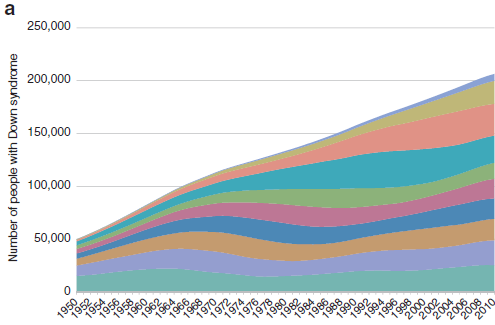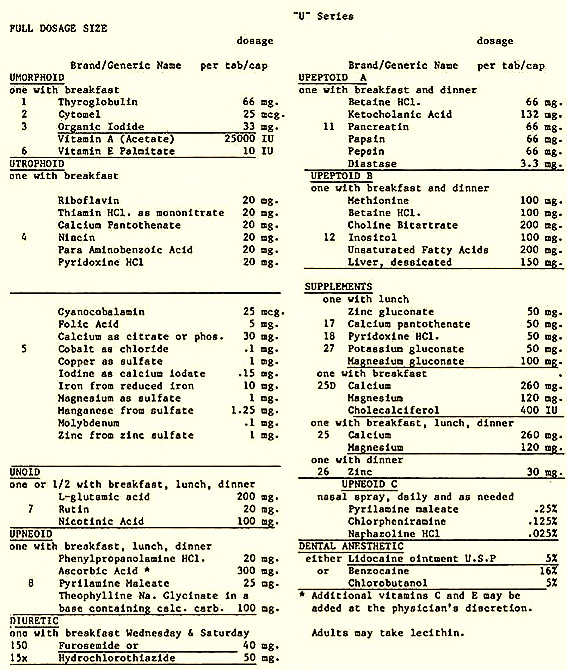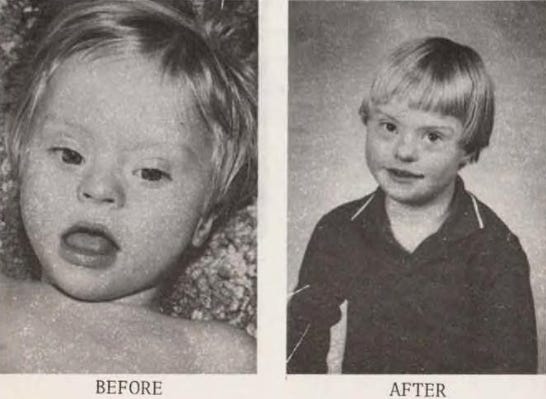Curing Down's Syndrome
"The treatment of Down's syndrome is something like a challenge against hopelessness." (1977)
We are generally told that what is genetic stays as such, yet when the rates of these same genetic disorders rise and multiply, the gene origin of disease becomes quite illogical. How can a genetic disorder increase in its rates of prevalence when the people who carry the disorder have some of the highest rates of infertility and reproductive issues?
When researching Down Syndrome, what initially struck me was its close resemblance to cretinism, both sharing many commonalities in physical and cognitive symptoms. Both disorders are marked by delayed physical and mental development, lack of awareness, and lowered IQ, except that congenital cretinism has a known cure (thyroid hormones), and downies are usually either left to their own devices or forced to role-play pro-social behaviours through therapy in an attempt to assimilate into society. There are powerful groups with vested interests in trying to eliminate births that are known to carry this disorder, a crime for which their conscience will one day have to answer for. With their stunted imaginations and determinisms, their solutions to problems can only be death.
Linus Pauling, the “I take 40 grams of vitamin C when I am sick” chemist, worked closely with Henry Turkel and had the most pleasant things to say about his work and character. Turkel is the doctor who created the U-Series protocol starting in the 1930s and ‘40s, as an orthomolecular approach (a term coined by Pauling himself, where disease can be treated by providing the correct substances in correct amounts) to treating downies, which places the disorder as metabolic in origin.
“I know Dr. Turkel, and can testify to his sincerity and conviction. The results that he reports are striking. There is evidence that patients would receive significant benefit…Dr. Turkel has developed, over a period of decades, a treatment of mentally retarded children with the use of vitamins, minerals, cerebral stimulants, and other substances. He has gathered together a convincing body of clinical observations showing that the genetic condition of mental retardation need not be accepted as inevitably leading to permanent defect and inability of the individual to function in normal society.” - Linus Pauling
The FDA, never betraying its convictions and its propensity for suppressing anything that may jeopardize its power and the interests of its financiers, repeatedly refused to approve Dr. Turkel’s treatment, banning its use across state lines, forcing parents to take their children to his clinic in Michigan. The Japanese government, leaning on the more sensible side of medicine, adopted his method to successfully treat thousands of Japanese children at over 60 medical centers, sponsored and sent its representatives to the US to learn from Turkel, and awarded him a medal for his work in 1974 (Rimland, 1994). The U-Series was adopted by various other countries like Norway, England, Canada, South Africa, and Switzerland, with parents sending in pictures and written testimonies of their children’s progress. The book “Medical Treatment of Down Syndrome and Genetic Diseases” outlines all the details and is worth reading (link). Georgi’s short article on this subject is also informative (link).
The U-Series was essentially a collection of vitamins, minerals, hormones, and antihistamines (thyroid, vitamins A/C/E, B-complex, minerals such as zinc, magnesium, selenium, potassium, and calcium, digestive enzymes, diuretics, and lidocaine) that were prescribed to children and whose progress was tracked.
An increase in IQ, reading comprehension, and social skills was observed. Nonverbal children developed vocabulary in mere months. Motor skills and physical symptoms improved (grew in height, slimmed down, cross eyes, and posture were partially corrected), and children became more independent, cooperative, and less frustrated. Some made so much progress that they graduated on the honor roll and went on to college. An eleven-year-old named Jimmy had an IQ of 41 at the age of 11. Within two years, it had increased to 68.
“During the first 9 months of ‘U’ Series treatment, his IQ, as tested by the school district, went from 81 to 113. By July 22, 1981, the school district stated his IQ was 123.“
The examples below are just a few, and while they don’t demonstrate a full reversal of the disorder, there are clear improvements in appearance, and the increased capacity for awareness is marked by the shift in gaze. In nearly every “after” example in the book, the children are smiling!
Downies have been shown to have significantly higher prolactin, TSH, estrogen, and uric acid levels; testosterone is lower (Hestnes et al., 1991; Attia et al., 2014). These most likely drive the high rates of spermatogenesis defects in men and premature menopause in women (Parizot et al., 2019). They have lower body temperatures (LuMind 2025), lower resting heart rate (Prasher 2024), significantly higher rates of obesity and heart disease, and 50% are born with congenital heart disease (Dimopoulos et al., 2023). These are all classic biomarkers for low thyroid function, and it is astonishing how these basic connections are overlooked with the inevitable conclusion of condemning them as incurable. The simple fact that individuals with chromosomal mosaicism can show no phenotypical defects should at least point to a multifactorial origin of Down’s syndrome.
People are not fond of the idea of IQ being malleable because it contradicts a tenet of race realism, but Katharina Dalton’s studies, alongside others exploring IQ differences between twins (Jensen, 1970) as well as nutrition (Harrell et al., 1981), unequivocally point to intelligence being fluid and environmentally influenced. The degree of this influence is not known. If the thyroid governs awareness and abstract thought, and the capacity for it, as well as pattern recognition, defines intelligence, then health and IQ are very closely interlinked, and when the former suffers, the latter follows suit.
References
Attia, Abdalla M.; El Naqeeb, Heba H.; and Ghanayem, Naglaa M. (2014) "Sexual and reproductive functions in men with Down«SQ»s syndrome," Menoufia Medical Journal: Vol. 28: Iss. 2, Article 34. DOI: https://doi.org/10.4103/1110-2098.163904
Dimopoulos, K., Constantine, A., Clift, P., Condliffe, R., Moledina, S., Jansen, K., Inuzuka, R., Veldtman, G. R., Cua, C. L., Tay, E. L. W., Opotowsky, A. R., Giannakoulas, G., Alonso-Gonzalez, R., Cordina, R., Capone, G., Namuyonga, J., Scott, C. H., D'Alto, M., Gamero, F. J., Chicoine, B., … for Down Syndrome International (DSi) (2023). Cardiovascular Complications of Down Syndrome: Scoping Review and Expert Consensus. Circulation, 147(5), 425–441. https://doi.org/10.1161/CIRCULATIONAHA.122.059706
Harrell, R. F., Capp, R. H., Davis, D. R., Peerless, J., & Ravitz, L. R. (1981). Can nutritional supplements help mentally retarded children? an exploratory study. Proceedings of the National Academy of Sciences of the United States of America, 78(1), 574–578. https://doi.org/10.1073/pnas.78.1.574
Hestnes, A., Stovner, L. J., Husøy, O., Følling, I., Fougner, K. J., & Sjaastad, O. (1991). Hormonal and biochemical disturbances in Down's syndrome. Journal of mental deficiency research, 35 ( Pt 3), 179–193. https://doi.org/10.1111/j.1365-2788.1991.tb01051.x
Jensen A. R. (1970). IQ's of identical twins reared apart. Behavior genetics, 1(2), 133–148. https://doi.org/10.1007/BF01071829
Parizot, E., Dard, R., Janel, N., & Vialard, F. (2019). Down syndrome and infertility: what support should we provide?. Journal of assisted reproduction and genetics, 36(6), 1063–1067. https://doi.org/10.1007/s10815-019-01457-2
Prasher, V. (2024, March 31). Screening of medical problems in adults with down syndrome. Down Syndrome Research and Practice. https://www.down-syndrome.org/en-us/library/research-practice/02/2/screening-medical-problems-adults-down-syndrome/
Rimland, B. (1994). Down Syndrome Researcher Henry Turkel, MD, 1903-1992. Sci-hub. https://sci-hub.ru/https://doi.org/10.3109/13590849409034561
Temperature regulation in people with down syndrome. LuMind IDSC Foundation. (2025, May 22). https://lumindidsc.org/temperature-regulation-in-people-with-down-syndrome







Fascinating article. I appreciate the nod to the malleability of IQ at the end of the article. This is actually a white pill as it provides hope for the billions of essentially retarded people worldwide.
you article rendered me breathless.